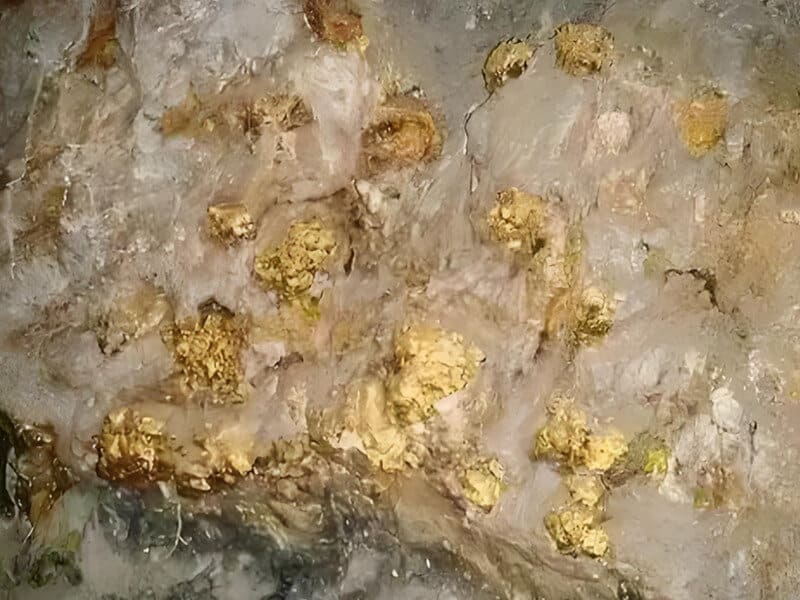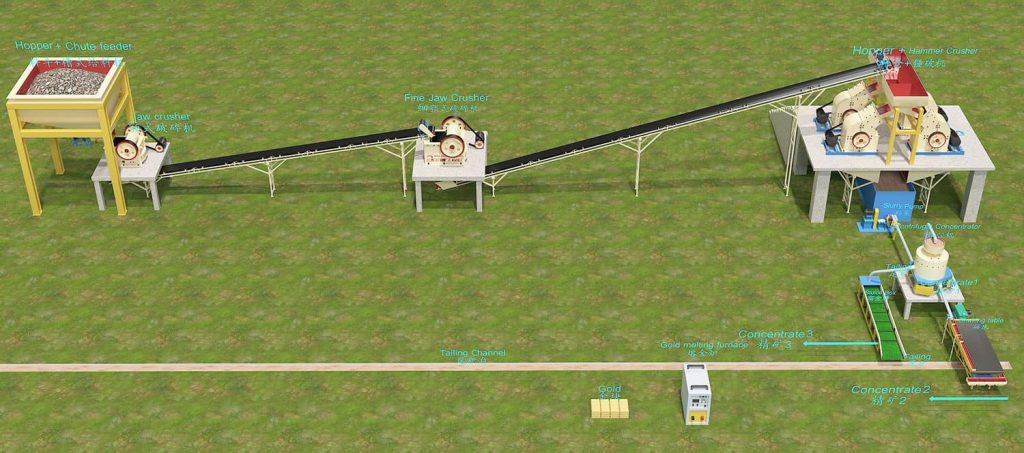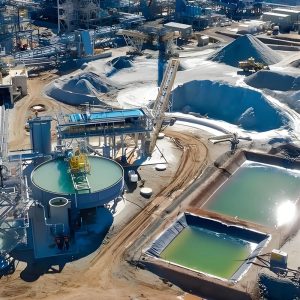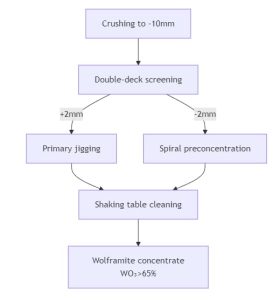Gold has been a precious metal sought after for centuries, not only for its beauty but also for its economic value. Among the various types of gold deposits, oxidized gold ores are particularly significant due to their relative ease of processing compared to sulfide ores. These ores are formed through natural weathering processes near the Earth’s surface, where exposure to oxygen and water transforms primary gold-bearing minerals into more extractable forms. This article explores the nature of oxidized gold ores, their refining methods, and the standard processes used in the industry to maximize gold recovery efficiently and cost-effectively.
Overview of Oxidized Gold Ore
Oxidized gold ore refers to secondary gold deposits formed when primary gold ore bodies undergo physical and chemical weathering near the surface or in shallow environments. In such deposits, gold exists mainly in free form or combined with oxidized minerals, exhibiting unique characteristics distinct from primary gold ores.
Main Features of Oxidized Gold Ore
Mineral Composition: Primarily oxidized minerals such as limonite, hematite, and malachite.
Gold Occurrence: Mostly fine free gold particles or adsorbed on iron-manganese oxide surfaces.
Distribution Characteristics: Typically located in the oxidation zone above primary ore deposits, generally at depths not exceeding 50–200 meters.
Ore Properties: Porous structure, good permeability, low clay content.

In the gold mining industry, oxidized gold ore is often prioritized for development due to its ease of processing. Compared to sulfide gold ore, oxidized gold ore achieves higher gold recovery rates and lower production costs, making its exploitation and utilization highly significant.
Refining Methods for Oxidized Gold Ore
Given the unique properties of oxidized gold ore, the modern metallurgical industry has developed various refining techniques. The following are the main refining methods and their applicable conditions:
1. Direct Cyanidation
Principle: Uses cyanide solution to dissolve gold from the ore.
Applicable Conditions: Coarse gold particles (>30 µm), low content of interfering elements in the ore.
Advantages: Mature process, simple equipment, low investment.
Recovery Rate: Typically 85%–95%.
2. Heap Leaching
Basic Principle: Crushed ore is stacked on an impermeable liner, and a sodium cyanide solution is sprayed to leach gold.
Applicable Conditions: Low-grade (0.5–2 g/t) oxidized gold ore with good permeability.
Process Flow: Crushing → Piling → Spraying → Adsorption of pregnant solution → Desorption and electrolysis.
Advantages: Low capital cost, cost-effective, suitable for large-scale low-grade ore.
3. Carbon-in-Pulp (CIP)
Process Features: Simultaneous cyanide leaching and activated carbon adsorption.
Applicable Conditions: Oxidized ores with higher clay content or finer gold particles.
Advantages: High gold recovery, low reagent consumption.
4. Hybrid Processing Techniques
Common Combinations: Flotation + cyanidation, gravity separation + cyanidation.
Applicable Scope: Complex oxidized gold ores with varied mineral composition.
Process Purpose: Pre-concentration or removal of interfering elements.
Selection Criteria for Refining Methods
- Ore properties (gold grade, mineral composition, dissemination characteristics, etc.).
- Economic feasibility (investment scale, operational costs).
- Environmental requirements (tailings treatment, cyanide management).
- Geographical factors (water resources, power supply, transportation conditions).

Oxide Gold Ore Refining Process
Due to the special properties of oxidized gold ore, the refining process requires multiple steps to achieve effective gold recovery. The following are the main refining steps:
1. Ore pretreatment
Ore pretreatment is the first step in the refining of oxidized gold ore, which directly affects the subsequent leaching efficiency and gold recovery rate. It is necessary to gradually optimize the ore state through multiple steps.
(1) Crushing operation
The original ore is sent to the crusher and crushed to a particle size of 20-50 mm through processes such as extrusion and impact. This step can disrupt the natural structure of the ore, making the gold particles embedded within the ore more accessible, thereby creating favorable conditions for subsequent grinding and leaching, and facilitating the transportation and subsequent processing of the ore.
(2) Ball milling operation
The crushed ore enters the ball mill and is further refined under the grinding action of steel balls, usually reaching a fineness of about -200 mesh, accounting for about 80%. This step is the key to ore dissociation. It can fully separate the gold particles from the gangue minerals, ensure that the gold particles can fully contact the subsequent leaching reagents, and greatly improve the leaching efficiency of gold.
(3) Screening operation
The ore pulp after ball milling is graded by screening equipment (such as a vibrating screen), and the coarse particles that do not meet the fineness requirements are screened out and returned to the ball mill for re-grinding. Screening can ensure that the ore pulp entering the leaching process has a uniform particle size, avoiding the inability to fully expose the gold particles due to too coarse particles, or the difficulty of subsequent solid-liquid separation due to too fine particles, thereby stabilizing the efficiency of the entire refining process.
2. Leaching operation
The leaching operation is a key step in gold extraction. The cyanide leaching method is currently commonly used. The pretreated ore pulp is placed in the leaching tank, and a cyanide solution (such as sodium cyanide) is added. At the same time, oxygen or air is introduced to dissolve the gold to form a gold-cyanide complex. During the leaching process, parameters such as cyanide concentration, slurry pH (typically kept at 10-11), and leaching time (generally 24-48 hours) must be strictly controlled to maximize gold leaching efficiency.
3. Solid-Liquid Separation
After leaching is complete, solid-liquid separation is required to separate the solution containing the gold-cyanide complex (precious solution) from the slag (tailings). Commonly used equipment includes filters and thickeners. Filters filter the liquid from the slurry through a filter cloth, producing a precious solution and filter residue. Thickeners use gravity to cause solid particles in the slurry to settle to the bottom, forming an underflow (tailings). The supernatant is the precious solution.
4. Gold Recovery
Gold recovery from precious solution typically involves zinc powder replacement. Zinc powder is added to the precious solution and, under stirring, displaces the gold from the gold-cyanide complex, forming a gold sludge. During the replacement process, factors such as the amount of zinc powder, reaction temperature, and stirring intensity must be controlled to maximize the gold replacement efficiency. After the exchange is complete, the gold mud is separated from the solution by filtration.
5. Gold Mud Purification
The resulting gold mud contains gold, silver, and other impurities, requiring purification to obtain pure gold. First, the gold mud is acid-washed to remove soluble impurities such as zinc and iron. Next, pyrometallurgy is performed. The acid-washed gold mud is placed in a furnace and melted at high temperatures. A slag-forming agent is added to separate the impurities from the gold by forming slag. Finally, electrolytic refining is performed. The crude gold obtained from the pyrometallurgy serves as the anode, and a pure gold sheet serves as the cathode. Current is passed through the electrolyte, dissolving the impurities in the crude gold into the electrolyte while the pure gold precipitates at the cathode, resulting in gold of higher purity.
Conclusion
Oxidized gold ores represent a critical resource in gold mining due to their higher processing efficiency and lower costs compared to sulfide ores. The choice of refining method—whether direct cyanidation, heap leaching, or CIP—depends on ore characteristics and economic considerations. Heap leaching, in particular, has become a widely adopted method for low-grade oxidized gold ores, offering an economically viable solution with efficient gold recovery.
With advancements in automation and environmental controls, the industry continues to enhance gold extraction while minimizing ecological impacts. Proper tailings management and cyanide detoxification ensure sustainable mining practices. Moving forward, continued innovation in processing technologies will further improve efficiency, making oxidized gold ore an increasingly valuable asset in the global gold supply chain.



